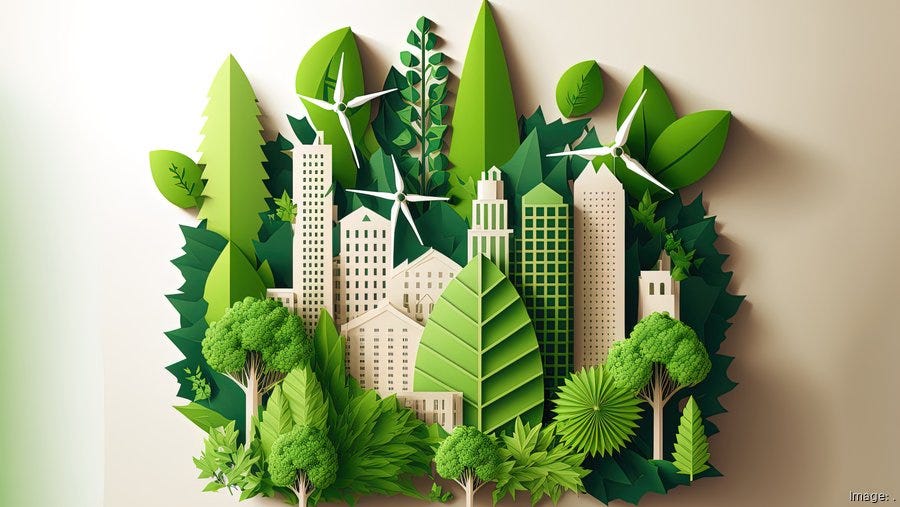The construction industry is undergoing a sustainability revolution driven by the urgent need to reduce the environmental impact of buildings. Constructing, operating, and demolishing buildings accounts for nearly 42% of annual global CO2 emissions and consumes enormous amounts of energy and resources. However, the growing adoption of innovative sustainable building materials and methods provides immense opportunities to transform construction into a regenerative system that gives back more than it takes.
Decarbonization & Circularity
Construction materials and products account for 11% percent of global carbon emissions, meaning significant decarbonization is essential to achieving net zero emissions. In addition to switching raw material inputs, manufacturers across categories ranging from steel to ceiling tiles are actively working to electrify processes and transition to renewable energy.
The embrace of circular economy principles within the built environment also offers new opportunities to turn waste into resources. For instance, reclaimed brick, wood, and even recycled glass are being incorporated into new buildings, keeping materials in use. Construction & demolition waste like crushed concrete can replace virgin inputs in making fresh concrete.
And product takeback programs enable old ceiling panels, insulation, carpets, shingles and more to be reused or recycled instead of landfilled. Circular business models such as materials as a service—where manufacturers retain ownership of products and handle takebacks—also incentivize designing for durability, reuse, and recyclability.
Technology Driving Innovation
Breakthrough technologies are unlocking game changing advances in sustainable building materials ranging from low-carbon cement alternatives to highly efficient, toxin-free insulation.
For example, research have demonstrated the viability of cement made from captured carbon emissions or renewable biominerals that absorb CO2 during processing. Startups are also exploring 3D printing cement and aggregate materials only where structurally required to reduce waste.
Plant-based bio composites combining agricultural residues like hemp or flax with natural binders show promise as lightweight, biodegradable insulation and structural materials. And phase change materials offer clever thermal storage solutions to passively regulate indoor temperatures without energy use.
Blockchain-enabled supply chain traceability platforms also now empower responsible sourcing and transparency around the origins and impacts of manufactured building products. And the integration of sensors into products will provide data to better monitor and optimize energy, durability and circularity.
The Next Building Products Revolution
Forward-thinking manufacturers, policymakers, architects, and builders are coming together to realize a more sustainable and resilient built environment for the 21st century. The construction sector clearly has far to go in improving its massive environmental footprint. But incredible progress is happening today to scale regenerative products across global supply chains.
Mainstream adoption of recycled, natural, non-toxic and low-carbon materials marks a turning point for the ecological construction transition already underway. And continued technological advances combined with circular business models will further unlock efficiencies while also meeting customer demand.
Green Building Products Key to Climate Goals
Achieving global climate goals will be impossible without transforming the building and construction sector. Operational emissions from existing building stock comprise 28% percent of total CO2 emissions when factoring in electricity usage. And with cities expected to double their building floorspace by 2060, the decisions around new material usage carry extreme gravity. Simply put, reaching net zero will require rapid mainstream adoption of certified low-carbon, energy-efficient building materials and products.
Green building labels and standards ensuring responsible raw material sourcing, ingredient transparency, and multi-attribute sustainability performance data are pivotal to driving change. Product declarations and environmental certifications like Declare, Cradle to Cradle, and the UL Environmental Claim Validation harness the power of the free market to incentivize continuous improvements on embodied carbon, energy use, circularity and health.
Tax incentives for green construction can also accelerate demand, as evidenced by Singapore’s landmark Green Building Masterplan. And carbon pricing programs adding fees to high-global warming potential materials such as steel and concrete nudge product and design innovations. Unified and consistent product transparency regulations across regions will further enable greener procurement policies by major public and private developers.
While the upfront costs of sustainable building materials remain a barrier, lifecycle assessment tools quantifying long-term value are improving. Financial mechanisms like green leases that split savings between tenants and owners can balance incentives. And research confirms efficient envelope systems and high-performance HVAC equipment enabled by green product selection pays dividends in productivity, health, and real estate values, delivering an overall project ROI averaging under seven years.
Startups Driving Circular Innovation
The construction sector has lagged behind on embracing circular economy principles. However, dynamic startups are now racing to commercialize novel recycling solutions and alternative building materials to disrupt business as usual.
For instance, companies have developed proprietary methods for upcycling difficult-to-recycle plastic and fiber waste into durable outdoor decking, insulation, sound barriers and substitutes for timber, PVC and aggregate. Instead of downcycling, the maintain their structure and value.
Visionary green materials startups are also flipping the construction supply chain on their heads. Rather than extracting and demolishing, these innovators leverage bio-based feedstocks or reactive chemistry to grow structural products on-site or reformulate used materials into fresh stock.
Pilots demonstrating the capability to cultivate insulation and finishes from crop waste or substitute concrete with reusable polymer alternatives point towards halt halting landfill-clogging waste. Customizable bio composites cultured from mycelium and biopolymers present another promising materials platform.
And early adopters have introduced reusable shipping container-based pop-up offices/dwellings which can be continually reconfigured as needed. The principles of circular design and modular construction simplify disassembly for maintenance, reuse and refurbishment – saving future costs and emissions.
While still gaining traction, circular solutions and zero-waste manufacturing hold unique potential to make buildings regenerative. Governments can accelerate adoption by funding demonstration sites and decarbonization incentive programs while also shaping more progressive codes around design for deconstruction. The companies creatively closing material loops today offer a glimpse into the circular cities of tomorrow.
Final Words
With the UN projecting 2.3 trillion ft2 in new buildings needed worldwide by 2060, all signs point to green building products playing a leading role in sustainable development. The decisions made today around materials procurement and lifetime carbon management will ripple out for decades to come. By raising the bar on product transparency and holistic building performance, the construction industry can rebuild itself to support rather than degrade ecological and human health.


 Tech6 months ago
Tech6 months ago
 Tech8 months ago
Tech8 months ago
 Entertainment5 months ago
Entertainment5 months ago
 Tech8 months ago
Tech8 months ago
 Entertainment7 months ago
Entertainment7 months ago
 Entertainment8 months ago
Entertainment8 months ago
 Entertainment8 months ago
Entertainment8 months ago
 Life Style8 months ago
Life Style8 months ago


